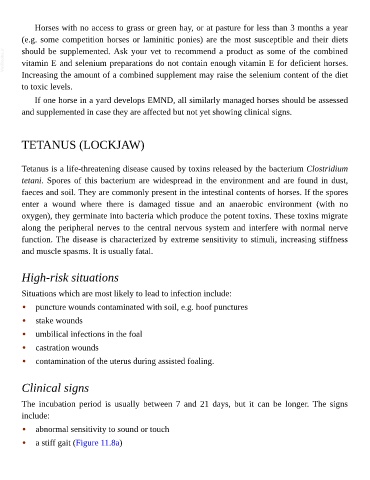Page 496 - The Veterinary Care of the Horse
P. 496
Horses with no access to grass or green hay, or at pasture for less than 3 months a year
(e.g. some competition horses or laminitic ponies) are the most susceptible and their diets
VetBooks.ir should be supplemented. Ask your vet to recommend a product as some of the combined
vitamin E and selenium preparations do not contain enough vitamin E for deficient horses.
Increasing the amount of a combined supplement may raise the selenium content of the diet
to toxic levels.
If one horse in a yard develops EMND, all similarly managed horses should be assessed
and supplemented in case they are affected but not yet showing clinical signs.
TETANUS (LOCKJAW)
Tetanus is a life-threatening disease caused by toxins released by the bacterium Clostridium
tetani. Spores of this bacterium are widespread in the environment and are found in dust,
faeces and soil. They are commonly present in the intestinal contents of horses. If the spores
enter a wound where there is damaged tissue and an anaerobic environment (with no
oxygen), they germinate into bacteria which produce the potent toxins. These toxins migrate
along the peripheral nerves to the central nervous system and interfere with normal nerve
function. The disease is characterized by extreme sensitivity to stimuli, increasing stiffness
and muscle spasms. It is usually fatal.
High-risk situations
Situations which are most likely to lead to infection include:
• puncture wounds contaminated with soil, e.g. hoof punctures
• stake wounds
• umbilical infections in the foal
• castration wounds
• contamination of the uterus during assisted foaling.
Clinical signs
The incubation period is usually between 7 and 21 days, but it can be longer. The signs
include:
• abnormal sensitivity to sound or touch
• a stiff gait (Figure 11.8a)

